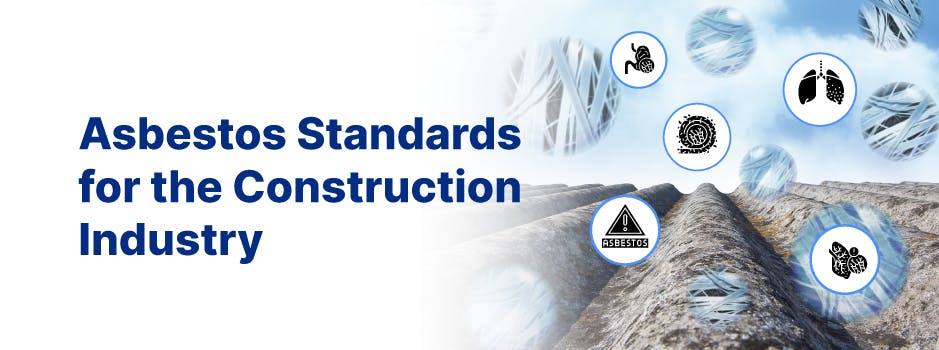Asbestos, a naturally occurring mineral, has a long history of use in the construction industry due to its heat-resistant properties and excellent tensile strength. However, it has since been classified as a hazardous material, as prolonged exposure to asbestos fibers can lead to severe health issues, including lung cancer, mesothelioma, and asbestosis. As a result, strict regulations have been put in place to safeguard the health and safety of workers in the construction industry. This blog post aims to provide a comprehensive guide to understanding and adhering to asbestos standards within the construction sector.
Understanding Asbestos and Its Dangers
Asbestos is a fibrous mineral that can be found in various forms, including chrysotile, amosite, crocidolite, tremolite, anthophyllite, and actinolite. Due to its versatility, asbestos was once widely used in numerous construction materials such as insulation, fireproofing, roofing, and flooring. However, when disturbed, asbestos can release microscopic fibers into the air, which can be inhaled by workers and cause life-threatening illnesses.
Regulations and Standards
Several government agencies and organizations are responsible for setting and enforcing asbestos regulations and standards in the construction industry. These include:
- Occupational Safety and Health Administration (OSHA)
- Environmental Protection Agency (EPA)
- National Institute for Occupational Safety and Health (NIOSH)
OSHA Asbestos Standards
OSHA has established two key asbestos standards to protect workers in the construction industry:
- 29 CFR 1926.1101 - Asbestos Construction Standard
- 29 CFR 1910.1001 - Asbestos General Industry Standard
Both standards outline the permissible exposure limits (PELs), exposure monitoring, hazard communication, and training requirements for construction workers who may come into contact with asbestos-containing materials (ACMs) or presumed asbestos-containing materials (PACMs).
Permissible Exposure Limits (PELs)
OSHA's asbestos standards specify that construction workers should not be exposed to airborne concentrations of asbestos greater than 0.1 fibers per cubic centimeter of air (f/cc) averaged over an eight-hour work shift. Additionally, workers should not be exposed to asbestos concentrations greater than 1.0 f/cc for any 30-minute period during the workday.
Exposure Monitoring and Assessment
Employers are required to conduct initial exposure assessments to determine if workers may be exposed to asbestos at or above the action level of 0.1 f/cc. If the assessment shows that workers are exposed to asbestos at or above this level, employers must implement appropriate engineering controls and work practices to reduce exposure.
Hazard Communication
Employers must communicate the hazards associated with asbestos exposure to their employees, ensuring that they understand the potential risks and the necessary precautions to take. This includes providing labels, signs, and safety data sheets (SDSs) for all asbestos-containing materials and training employees on how to work safely with these materials.
Training Requirements
All workers who may be exposed to asbestos must receive comprehensive training to recognize the hazards and to understand the necessary procedures for preventing exposure. Training should cover topics such as:
- The health effects of asbestos exposure
- The relationship between
- The role of OSHA 10 and OSHA 30 training programs in asbestos safety
OSHA 10 and OSHA 30 Training Programs
In addition to the asbestos-specific training, workers in the construction industry are often required to complete either the OSHA 10-hour or OSHA 30-hour training course, depending on their job responsibilities and the level of risk associated with their tasks. These training programs, designed to educate workers about general safety and health regulations, can help improve overall safety standards in the industry, including asbestos awareness.
The OSHA 10-hour training program is designed for entry-level workers and covers essential safety topics, such as recognizing and avoiding common workplace hazards. The OSHA 30-hour training program, on the other hand, is more comprehensive and intended for construction supervisors, managers, and workers with more extensive safety responsibilities. Both programs address asbestos hazards and the importance of adhering to asbestos standards and regulations, ensuring that workers understand the risks and know how to protect themselves.
Best Practices for Asbestos Management in Construction
To minimize the risks associated with asbestos exposure in the construction industry, employers and workers should follow these best practices:
-
Identifying and managing asbestos-containing materials (ACMs): Employers should conduct thorough building surveys to identify ACMs before beginning any construction or renovation projects. ACMs should be labeled and managed according to regulatory requirements.
-
Developing an asbestos management plan: Employers should create a comprehensive asbestos management plan that outlines the procedures and controls for handling, removing, and disposing of asbestos-containing materials safely.
-
Using proper engineering controls and work practices: Employers should implement engineering controls, such as ventilation systems and wet methods, to reduce airborne asbestos levels. Additionally, workers should follow safe work practices, including wearing personal protective equipment (PPE) and using proper containment and decontamination procedures.
-
Regularly monitoring and maintaining asbestos-containing materials: Employers should conduct regular inspections to ensure that ACMs are in good condition and are not posing a threat to workers' health. Damaged or deteriorating ACMs should be promptly repaired or removed by trained and certified professionals.
-
Educating and training workers: In addition to the mandatory asbestos training and OSHA 10 or OSHA 30 courses, employers should provide ongoing education and training for workers to ensure that they remain aware of the hazards associated with asbestos exposure and the necessary precautions to take.
In conclusion, adhering to asbestos standards and regulations is crucial for ensuring the safety and well-being of workers in the construction industry. By understanding the dangers associated with asbestos, complying with OSHA standards, participating in OSHA 10 and OSHA 30 training programs, and following best practices for asbestos management, both employers and workers can significantly minimize the risks associated with asbestos exposure and create a safer working environment for everyone.

